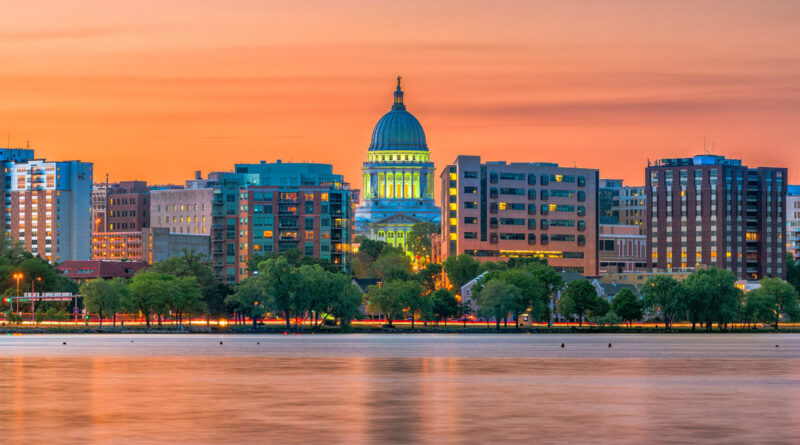History of Madison Wisconsin
Madison, Wisconsin, a city steeped in rich history and cultural significance, serves as the capital of the state and is home to a diverse population, vibrant educational institutions, and a robust political scene. Founded in the early 19th century, Madison has evolved from a small settlement into a bustling metropolis known for its picturesque lakes, thriving technology sector, and progressive values. This article delves into the historical journey of Madison, exploring its origins, growth, and the pivotal moments that shaped it into the city it is today.
Pre-Colonial History
Long before European settlers arrived, the area now known as Madison was inhabited by the Ho-Chunk Nation. This indigenous tribe, also referred to as the Winnebago, had lived in the region for thousands of years, establishing a rich cultural and spiritual connection with the land. The area’s natural resources, including the four glacial lakes—Mendota, Monona, Waubesa, and Kegonsa—provided sustenance and supported a thriving community. The Ho-Chunk people played a vital role in shaping the landscape, with their traditions and way of life deeply intertwined with the natural environment.
European Exploration and Early Settlement
The first Europeans to explore the area were French fur traders in the early 17th century. These traders established routes and trading posts throughout the region, interacting with the Ho-Chunk and other indigenous tribes. The French influence in the region was marked by trade and occasional conflict, but it wasn’t until the late 18th century that more permanent European settlements began to emerge.
The early 19th century saw an influx of settlers from the eastern United States, attracted by the fertile land and the promise of opportunity in the burgeoning frontier. This period of early settlement laid the groundwork for the formal establishment of Madison.
Founding of Madison (1836)
In 1836, James Duane Doty, a land speculator and former federal judge, purchased over a thousand acres of land between Lakes Mendota and Monona, envisioning the site as an ideal location for the new capital of the Wisconsin Territory. Doty named the city Madison, in honor of James Madison, the fourth President of the United States, and began laying out a city plan that included a central square for the Capitol building.
Doty’s vision for Madison was grand, but the reality was more modest. The city’s early development was slow, hampered by harsh winters, limited infrastructure, and the challenges of attracting new settlers. However, Madison’s designation as the territorial capital provided a crucial impetus for growth.
Early Development and Growth (1837-1850)
After Madison was designated the capital of Wisconsin Territory in 1837, its growth began to accelerate. The construction of the Capitol building started in 1837, drawing laborers, tradespeople, and government officials to the area. The city’s layout, designed by Doty, featured a grid system centered around the Capitol Square, with wide streets and public spaces intended to reflect the grandeur of other American capitals.
Despite its strategic importance, Madison remained a small town throughout the 1840s, with limited infrastructure and amenities. The population was sparse, and the economy was largely based on agriculture and government. However, the arrival of the University of Wisconsin in 1848 marked a significant turning point, laying the foundation for Madison’s future as an educational and cultural hub.
Madison During the Civil War (1861-1865)
The outbreak of the Civil War in 1861 had a profound impact on Madison. As the state capital, Madison was a center for recruitment, training, and organization of troops. Camp Randall, located on the outskirts of the city, served as a training ground for Union soldiers and later as a prisoner-of-war camp for Confederate soldiers.
The war years brought economic growth to Madison as the demand for goods and services increased to support the war effort. The city’s population grew as people moved in to take advantage of the economic opportunities, and the infrastructure expanded to accommodate the needs of a wartime society. Madison’s role in the Civil War solidified its importance within Wisconsin and set the stage for its post-war expansion.
Post-Civil War Expansion (1865-1900)
Following the Civil War, Madison experienced significant growth and transformation. The city’s economy diversified, with manufacturing, commerce, and education becoming increasingly important. The establishment of the University of Wisconsin-Madison as a leading educational institution attracted students and faculty from across the country, fostering a culture of innovation and intellectualism.
Infrastructure improvements, including the expansion of railroads and the development of public utilities, further stimulated Madison’s growth. The population surged, and the city’s boundaries expanded to accommodate new residential neighborhoods, businesses, and industrial facilities. By the end of the 19th century, Madison had established itself as a dynamic and prosperous city.
The Progressive Era (1900-1920)
The early 20th century was marked by the rise of the Progressive movement, which had a profound influence on Madison’s political and social landscape. Robert M. La Follette, a native of Wisconsin and a key figure in the Progressive movement, served as Governor of Wisconsin and later as a U.S. Senator. His advocacy for political reform, social justice, and government accountability resonated deeply in Madison, where the Progressive ideals took root.
During this period, Madison saw improvements in public services, education, and infrastructure. The city became a center for progressive thought and action, with the University of Wisconsin playing a pivotal role in advancing social and political change. The Progressive Era left a lasting legacy in Madison, shaping its identity as a city committed to innovation and reform.
Madison in the Great Depression (1930s)
The Great Depression of the 1930s brought significant challenges to Madison, as it did to much of the nation. Unemployment soared, businesses closed, and many families faced financial hardship. However, Madison’s resilience was evident as the city responded to the crisis with a combination of federal assistance, community support, and local initiatives.
The New Deal programs introduced by President Franklin D. Roosevelt provided much-needed relief and economic stimulus to Madison. Public works projects, such as the construction of schools, parks, and roads, helped to alleviate unemployment and improve the city’s infrastructure. Despite the hardships, Madison emerged from the Depression with a stronger sense of community and a renewed commitment to public service.
World War II and Post-War Boom
World War II brought another period of transformation to Madison. The city contributed to the war effort through manufacturing, research, and military training. The University of Wisconsin-Madison played a critical role in scientific research and development, particularly in areas related to the war, such as radar technology and materials science.
After the war, Madison experienced a population boom as returning veterans and their families settled in the city. This post-war period saw the rapid expansion of suburban neighborhoods, schools, and commercial districts. The city’s economy diversified further, with growth in the education, healthcare, and technology sectors. Madison’s population and infrastructure grew significantly, setting the stage for its emergence as a major Midwestern city.
Civil Rights Movement in Madison (1960s)
The 1960s were a time of social and political upheaval across the United States, and Madison was no exception. The city became a hotbed of student activism, particularly on the University of Wisconsin-Madison campus. Protests against racial discrimination, the Vietnam War, and other social injustices were common, reflecting the broader national movements for civil rights and social change.
Madison’s involvement in the Civil Rights Movement included significant contributions from students, faculty, and local activists. The city’s progressive values were tested and strengthened during this period, as residents advocated for equality, justice, and peace. The legacy of the 1960s continues to influence Madison’s culture and politics today.
Madison in the 1970s-1980s
The 1970s and 1980s were decades of change and adaptation for Madison. The city faced economic challenges, including the decline of traditional manufacturing industries and the need to adapt to a changing economic landscape. However, Madison’s focus on education, technology, and healthcare helped it navigate these challenges.
During this time, Madison also saw significant growth in the technology and biotechnology sectors, with the University of Wisconsin-Madison playing a key role in fostering innovation. The city’s political landscape also evolved, with increased participation in local governance and the rise of new political movements. Madison’s ability to adapt and innovate during these decades laid the groundwork for its future success.
Madison in the 1990s
The 1990s marked a period of cultural evolution and urban development in Madison. The city’s population continued to grow, and with it came new cultural institutions, entertainment venues, and community spaces. The downtown area saw significant revitalization efforts, including the redevelopment of historic buildings and the creation of new public spaces.
Madison’s cultural scene flourished during this decade, with the city becoming known for its music, arts, and festivals. The growth of the technology sector continued, attracting new businesses and entrepreneurs to the city. Madison’s reputation as a progressive, vibrant, and welcoming community was solidified during the 1990s, attracting people from diverse backgrounds and contributing to the city’s dynamic atmosphere.
21st Century Madison (2000-Present)
The turn of the 21st century brought continued growth and change to Madison. The city emerged as a major player in the technology and biotechnology industries, with a strong focus on innovation and research. The University of Wisconsin-Madison continued to be a driving force in the city’s economy, attracting students, researchers, and businesses to the area.
Madison’s population grew steadily, with new residential developments and urban planning initiatives aimed at accommodating the city’s growth while preserving its natural beauty and historic character. The city also made significant strides in environmental sustainability, with efforts to reduce carbon emissions, promote green energy, and protect natural resources.
In recent years, Madison has faced new challenges, including issues related to housing affordability, social equity, and climate change. However, the city’s strong sense of community, commitment to progressive values, and focus on innovation continue to guide its development and ensure its resilience in the face of change.
Madison’s Cultural and Architectural Legacy
Madison’s rich cultural and architectural legacy is evident in its historic landmarks, museums, and public spaces. The Wisconsin State Capitol, completed in 1917, stands as a symbol of the city’s political and architectural heritage. The Capitol Square is the heart of Madison, hosting a variety of events, from farmers’ markets to political protests.
The University of Wisconsin-Madison’s campus is home to numerous historic buildings, museums, and cultural institutions that contribute to the city’s intellectual and artistic life. The Chazen Museum of Art, the Wisconsin Historical Society, and the Memorial Union Terrace are just a few examples of Madison’s vibrant cultural scene.
Madison’s neighborhoods, with their diverse architectural styles and historic homes, reflect the city’s evolution over time. Efforts to preserve and protect these historic sites are ongoing, ensuring that Madison’s unique character is maintained for future generations.
The Future of Madison
Looking ahead, Madison faces both opportunities and challenges as it continues to grow and evolve. The city’s population is expected to increase, driven by its strong economy, educational opportunities, and quality of life. However, this growth will require careful planning to ensure that Madison remains a livable, sustainable, and inclusive community.
Key issues for Madison’s future include addressing housing affordability, promoting social equity, and mitigating the impacts of climate change. The city’s leaders and residents are actively engaged in these discussions, working to develop policies and initiatives that will shape Madison’s future.
Madison’s role in state and national politics is likely to remain significant, given its status as the state capital and its history of political activism. The city’s commitment to progressive values, innovation, and community engagement will continue to guide its development, ensuring that Madison remains a vibrant and dynamic place to live, work, and visit.
Frequently Asked Questions (FAQs)
- What was the original name of Madison, Wisconsin?
- Madison was named by James Duane Doty in honor of James Madison, the fourth President of the United States. Before its founding, the area did not have an official European name, as it was inhabited by the Ho-Chunk Nation.
- Why was Madison chosen as the capital of Wisconsin?
- Madison was chosen as the capital of Wisconsin Territory due to its central location between Milwaukee and the Mississippi River, as well as James Duane Doty’s influence and land ownership in the area.
- How did the University of Wisconsin-Madison influence the city’s development?
- The University of Wisconsin-Madison has been a major driver of Madison’s growth and development, attracting students, faculty, and research institutions, which in turn have stimulated the local economy and cultural scene.
- What role did Madison play during the Civil War?
- Madison served as a key center for recruiting and training Union soldiers during the Civil War, with Camp Randall playing a significant role as a military training ground and later as a prisoner-of-war camp.
- How has Madison’s economy evolved over time?
- Madison’s economy has evolved from a primarily agricultural and government-based economy to a diverse one that includes education, technology, healthcare, and biotechnology sectors.
- What are some key historical landmarks in Madison?
- Some key historical landmarks in Madison include the Wisconsin State Capitol, the University of Wisconsin-Madison campus, the Frank Lloyd Wright-designed Monona Terrace, and various historic neighborhoods.
Conclusion
Madison, Wisconsin, is a city with a rich and diverse history that reflects its evolution from a small territorial capital to a thriving modern metropolis. From its indigenous roots and early European settlement to its role in the Civil War, the Progressive Era, and beyond, Madison’s history is a testament to the resilience, innovation, and community spirit of its people. As Madison continues to grow and change, its past provides a strong foundation for its future, ensuring that it remains a vibrant and dynamic city for generations to come.
Discover more from City Towner
Subscribe to get the latest posts sent to your email.




